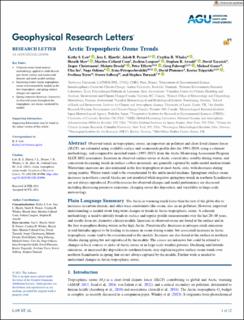| dc.contributor.author | Law, Kathy S. | |
| dc.contributor.author | Hjorth, Jens Liengaard | |
| dc.contributor.author | Pernov, Jakob B. | |
| dc.contributor.author | Whaley, Cynthia | |
| dc.contributor.author | Skov, Henrik | |
| dc.contributor.author | Coen, Martine Collaud | |
| dc.contributor.author | Langner, Joakim | |
| dc.contributor.author | Arnold, Stephen R. | |
| dc.contributor.author | Tarasick, David | |
| dc.contributor.author | Christensen, Jesper | |
| dc.contributor.author | Deushi, Makoto | |
| dc.contributor.author | Effertz, Peter | |
| dc.contributor.author | Faluvegi, Greg | |
| dc.contributor.author | Gauss, Michael | |
| dc.contributor.author | Im, Ulas | |
| dc.contributor.author | Oshima, Naga | |
| dc.contributor.author | Petropavlovskikh, Irina | |
| dc.contributor.author | Plummer, David | |
| dc.contributor.author | Tsigaridis, Kostas | |
| dc.contributor.author | Tsyro, Svetlana | |
| dc.contributor.author | Solberg, Sverre | |
| dc.date.accessioned | 2023-12-04T08:13:16Z | |
| dc.date.available | 2023-12-04T08:13:16Z | |
| dc.date.created | 2023-11-22T13:00:46Z | |
| dc.date.issued | 2023 | |
| dc.identifier.citation | Geophysical Research Letters. 2023, 50, e2023GL103096. | en_US |
| dc.identifier.issn | 0094-8276 | |
| dc.identifier.uri | https://hdl.handle.net/11250/3105708 | |
| dc.description.abstract | Observed trends in tropospheric ozone, an important air pollutant and short-lived climate forcer (SLCF), are estimated using available surface and ozonesonde profile data for 1993–2019, using a coherent methodology, and compared to modeled trends (1995–2015) from the Arctic Monitoring Assessment Program SLCF 2021 assessment. Increases in observed surface ozone at Arctic coastal sites, notably during winter, and concurrent decreasing trends in surface carbon monoxide, are generally captured by multi-model median trends. Wintertime increases are also estimated in the free troposphere at most Arctic sites, with decreases during spring months. Winter trends tend to be overestimated by the multi-model medians. Springtime surface ozone increases in northern coastal Alaska are not simulated while negative springtime trends in northern Scandinavia are not always reproduced. Possible reasons for observed changes and model performance are discussed including decreasing precursor emissions, changing ozone dry deposition, and variability in large-scale meteorology. | en_US |
| dc.description.abstract | Arctic Tropospheric Ozone Trends | en_US |
| dc.language.iso | eng | en_US |
| dc.rights | Navngivelse 4.0 Internasjonal | * |
| dc.rights.uri | http://creativecommons.org/licenses/by/4.0/deed.no | * |
| dc.title | Arctic Tropospheric Ozone Trends | en_US |
| dc.title.alternative | Arctic Tropospheric Ozone Trends | en_US |
| dc.type | Peer reviewed | en_US |
| dc.type | Journal article | en_US |
| dc.description.version | publishedVersion | en_US |
| dc.rights.holder | © 2023. The Authors. | en_US |
| dc.source.volume | 50 | en_US |
| dc.source.journal | Geophysical Research Letters | en_US |
| dc.identifier.doi | 10.1029/2023GL103096 | |
| dc.identifier.cristin | 2200248 | |
| dc.relation.project | NILU: 7726 | en_US |
| dc.relation.project | AMAP: 2020-18 | en_US |
| dc.source.articlenumber | e2023GL103096 | en_US |
| cristin.ispublished | true | |
| cristin.fulltext | original | |
| cristin.qualitycode | 2 | |

